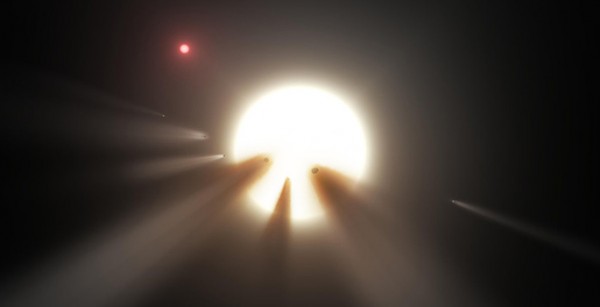Alien Megastructure Star Detected? No, Just Blame Blurry Instruments and Flawed Data
| Ana Verayo | | May 11, 2016 05:49 AM EDT |
(Photo : NASA/JPL/Caltech) Cascading comets around a distant star
The possibility of an "alien megastructure" in the star system KIC 8462852 just got dimmer. Researchers now say that this odd, dimming light emitted by the star over the last century can now be blamed on scientific instruments used for observations and not radioactive power indicating an advanced alien civilization.
Like Us on Facebook
Last October 2015, scientists suggested the existence of this advanced alien civilization that built a megastructure near its star to obtain its energy, since a large object appear to be blocking its light. This structure also known as a Dyson Sphere which could also provide clues about the mysterious dimming of exoplanets that is proven not to be produced by gas clouds and dust from comet collisions.
Another study published in the Astrophysical Journal just last January also presented "evidence" that this alien megastructure caused the dimming of KIC 8462852 by 20 percent over the past 100 years, that cannot be produced by natural causes.
Now, researchers from Vanderbilt University believe that past research are flawed where they studied 500,000 photographic glass plates that were captured in the past century. According to the team, these observations were produced from a variety of different telescopes and cameras, generating instrumental variations and producing inconsistent observations of KIC 8462852.
According to co-author of the study, Keivan Stassun, there are variations of brightness when it comes to a number of comparable stars where the database found that most of them experienced a drop of intensity in the 1960s. This would only mean that these changes are caused by instrumentation and technology and not due to the changing brightness of the stars.
The team says that the observed dips in brightness of KIC 8462852 are confirmed, however, the reason behind this is still unknown. Stassun also reveals that there was a series of unnatural and uneven dips in 2013 that lasted for 100 days, where Kepler Space Telescope data also contained these irregular dips, however, this was considered as an unusual swarm.
To date, the best theory for these dips in brightness of KIC 8462852 is that a giant comet or asteroid shattered into pieces, where its remnants have broken up into millions of smaller fragments, blocking the light of the stars. This new study will be published in the Astrophysical Journal.
Tagsalien megastructure, dyson sphere, KIC 8462852, Exoplanets, comets, asteroids, dimming star
©2015 Chinatopix All rights reserved. Do not reproduce without permission
EDITOR'S PICKS
-

Did the Trump administration just announce plans for a trade war with ‘hostile’ China and Russia?
-

US Senate passes Taiwan travel bill slammed by China
-

As Yan Sihong’s family grieves, here are other Chinese students who went missing abroad. Some have never been found
-

Beijing blasts Western critics who ‘smear China’ with the term sharp power
-

China Envoy Seeks to Defuse Tensions With U.S. as a Trade War Brews
-

Singapore's Deputy PM Provides Bitcoin Vote of Confidence Amid China's Blanket Bans
-

China warns investors over risks in overseas virtual currency trading
-

Chinese government most trustworthy: survey
-

Kashima Antlers On Course For Back-To-Back Titles
MOST POPULAR
LATEST NEWS
Zhou Yongkang: China's Former Security Chief Sentenced to Life in Prison

China's former Chief of the Ministry of Public Security, Zhou Yongkang, has been given a life sentence after he was found guilty of abusing his office, bribery and deliberately ... Full Article
TRENDING STORY

China Pork Prices Expected to Stabilize As The Supplies Recover

Elephone P9000 Smartphone is now on Sale on Amazon India

There's a Big Chance Cliffhangers Won't Still Be Resolved When Grey's Anatomy Season 13 Returns

Supreme Court Ruled on Samsung vs Apple Dispute for Patent Infringement

Microsoft Surface Pro 5 Rumors and Release Date: What is the Latest?










